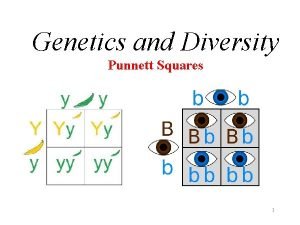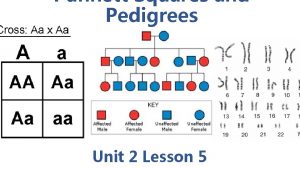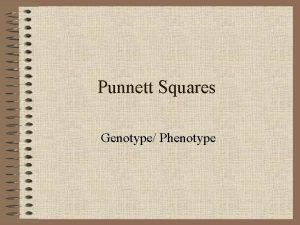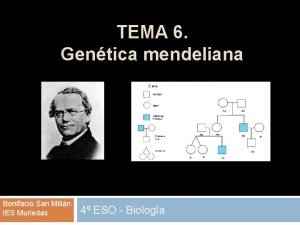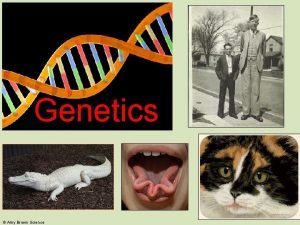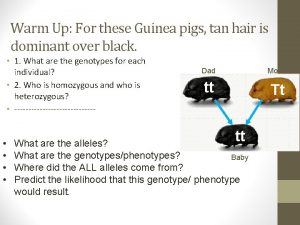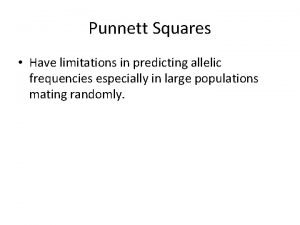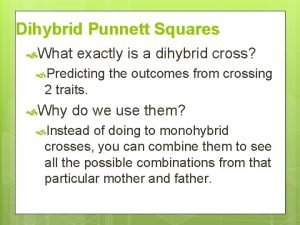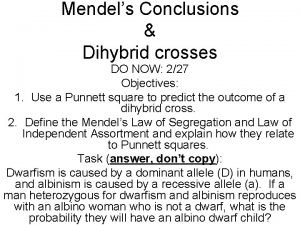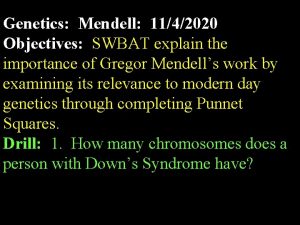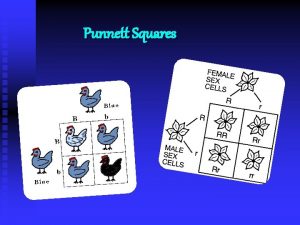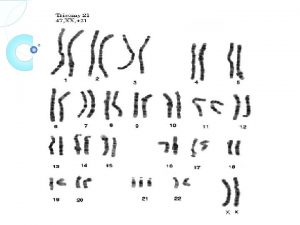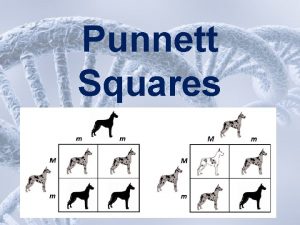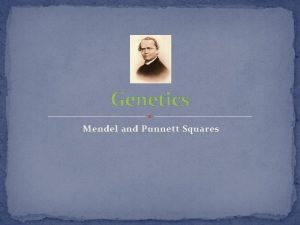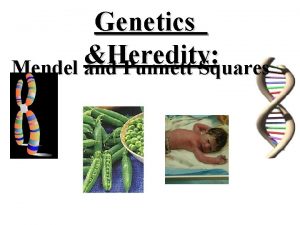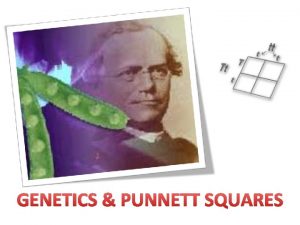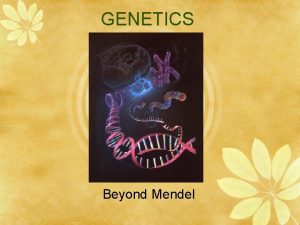Mendel Genetics and Punnett Squares Origin of Genetics





























- Slides: 29

Mendel Genetics and Punnett Squares üOrigin of Genetics üSteps of a Monohybrid cross üTerminology üPractice üPunnett Squares üDetermining Unknown Genotypes

Terminology • Heredity - the passing of characteristics from parents to offspring • Genetics - the branch of Biology that focuses on heredity • Cross - combining traits from two parents by breeding (sexual reproduction) • Trait - characteristic that can be passed down to a child from their parents carried on their chromosome (ex. Eye color, hair, height, etc)

The Origin of Genetics • Gregor Mendel – Austrian monk – Studied theology, science and mathematics – Noticed patterns in the pea plants he was growing – Mendel crossed pea plants and studied the genetic turn-outs – Was the first to develop rules that accurately predict patterns of heredity – Father of genetics

The Origin of Genetics • Why study pea plants? – They reproduce quickly – Easy to see their traits – Flowers, because of their structure, are easy to control reproduction (by self pollinating) • Self pollination occurs in plants that have both male and female reproductive structures on the same flower/plant. The plant is able to fertilize itself

The Origin of Genetics • Mendel discovered two types of organisms – Purebred - they receive the same traits from each parent (ex. Purebred yellow Labrador) – Hybrid - receive different traits from each parent (ex. Labradoodle)

Theory of Heredity • Based on Mendel’s observations: – For each trait, an individual has two copies of a gene- one from mom and one from dad – There alternative versions of genes called alleles – When 2 different alleles occur together 1 of them may be expressed (visible) while the other may have no effect on appearance – Each gamete (sperm/egg) contributes one allele

The Origin of Genetics • Mendel’s law of segregation – States that the members of each pair of alleles separate when gametes are formed • Mendel’s law of independent assortment – States that pairs of alleles separate independently of one another during meiosis (gamete formation)

Mendel’s 1 st Law: Law of Segregation – when any individual produces gametes, the 2 copies of a gene separate so that each gamete receives only one copy -SS S ss s Ss S or s Mendel’s 2 nd Law: Genes Assort Independently – alleles of different genes assort independently of one another during gamete formation

The Origin of Genetics Mendel used monohybrid crosses to study characteristics of pea plants Monohybrid cross- a cross that involved one pair of contrasting traits Ex. Crossing a round seed of a pea plant with a wrinkled seed of pea plant.

P generation- the parental generation of true-breeding individuals F 1 generation- first filial generation; offspring of the P generation resulting from crossing of contrasting traits F 2 generation- second filial generation; offspring from the self pollination of the F 1 generation

Another example

Terminology • Alleles - alternative versions of genes – The gene for hair color can have multiple alleles (blonde hair allele, brown hair allele, etc) • Dominant - the expressed (visible) trait – Allele written as a capital letter (B, R, G, etc) – It will typically mask or cover up recessive traits • Recessive - the trait that is not expressed or observable – Allele written as a lowercase letter (b, r, g, etc)

Problem If “B” is brown and “b” is blonde: • What trait would be visible for: – BB? – bb? – Bb?

Terminology • Homozygous - when two alleles of a particular gene are the same – (PP), (pp), (RR), (rr), (VV), (vv), etc • Heterozygous - when two alleles of a particular gene are different – Only the dominant allele is expressed while the recessive is present, but not expressed – (Pp), (Rr), (Vv), etc • capital letter is always written first!

Maternal chromosome that came from the egg of this person’s mother Heterozygous - only the dominant allele is expressed Homozygous dominant - both chromosomes have identical, dominant alleles Homozygous recessive -both chromosomes have identical, recessive alleles Paternal chromosome that came from the sperm of this person’s father

Terminology • Genotype - the set of genes or alleles an individual has for a trait – think “genes” and “letters” – (Rr), (RR) or (rr) – (Vv), (VV) or (vv) • Phenotype - the physical appearance of a trait – Think “face” and “colors” – White, purple, red, blonde, freckles, blue eyes, etc.



Practice (assume that P is purple and p is white) (Pp): What is the genotype? What is the phenotype? Is it homozygous or heterozygous?

Practice (assume that P is purple and p is white) (pp): What is the genotype? What is the phenotype? Is it homozygous or heterozygous?

Practice (assume that P is purple and p is white) (PP): What is the genotype? What is the phenotype? Is it homozygous or heterozygous?

Punnett Squares • Punnett square- is a diagram that predicts the outcome of a genetic cross by considering all possible combinations

Punnett Squares • Ex. Having freckles (F) is dominant to not having freckles (f). Parent 1 is heterozygous for freckles and Parent 2 is also heterozygous Parent 1 F Parent 2 f F Ff ff

Punnett Squares Box 1 is homozygous for…. Box 2 and 3 is…. . Box 4 is…. F F f FF Ff 1 f Ff 3 2 ff 4

• Once a punnett square is solved you can determine ratios of possible outcomes – Look at the combinations INSIDE the punnett square only – Genotypic ratio asks for the combination of alleles/letters – Phenotypic ratio asks for the combination of physical traits – Always written homozygous Genotypic Ratio: 1: 2: 1 dominant, heterozygous, Phenotypic Ratio: 3: 1 homozygous recessive – Numbers in the ratio MUST add up to the number of boxes in a punnett square

Practice • Ex. A homozygous yellow pea plant (Y) is dominant over a homozygous green pea plant (y). What’s the genotype of all offspring? Yy y Y Y Yy Yy What’s the phenotype of all offspring? yellow What’s the genotypic ratio? 4: 0 y Yy Yy What’s the phenotypic ratio? 4: 0

Determining Unknown Genotypes • When a phenotype is dominant but the genotype is not known, a test cross is performed. – You cross the unknown genotype with a homozygous recessive individual

Determining Unknown Genotypes What does that mean? You can physically see that the pea plant is yellow, but you don’t know if they are (YY) or (Yy). So, you cross the yellow pea plant with a recessive pea plant (yy) that is green. If the offspring are all yellow the genotype is (YY) If the offspring are ½ yellow and ½ green the genotype is (Yy)

Determining Unknown Genotypes • Doesn’t make sense? Use the Punnett Square and work backwards! Known, recessive genotype y Unknown genotype Y ? ? ? y
 Cross two heterozygous tall stem height
Cross two heterozygous tall stem height How many squares
How many squares What does a half filled in circle mean on a pedigree
What does a half filled in circle mean on a pedigree Section 11-2 probability and punnett squares
Section 11-2 probability and punnett squares 11-2 probability and punnett squares
11-2 probability and punnett squares 11-2 probability
11-2 probability Gregor mendel punnett square
Gregor mendel punnett square Punnett square
Punnett square Mendel and his peas lesson 1
Mendel and his peas lesson 1 Ley de mendel de la segregacion
Ley de mendel de la segregacion Who is the
Who is the My age
My age Pyr
Pyr X linked punnett square
X linked punnett square What are the limitations of punnett squares
What are the limitations of punnett squares Punnet square
Punnet square How to foil punnett squares
How to foil punnett squares Foil method punnett square
Foil method punnett square Foil method dihybrid crosses
Foil method dihybrid crosses The tech museum of innovation eye color
The tech museum of innovation eye color Dihybrid punnett square
Dihybrid punnett square A and b punnett square
A and b punnett square Sex linked punnett squares
Sex linked punnett squares Genotype punnet square
Genotype punnet square Dihybrid punnett square
Dihybrid punnett square What is the punnet square
What is the punnet square Genetic square
Genetic square Genetic square chart
Genetic square chart Pp x pp
Pp x pp Gregor mendel
Gregor mendel
